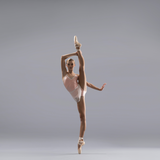Subject: The Dancing Plague of 1518
Where: Strasbourg, France
What: In July of 1518, an unbelievable epidemic gripped the medieval streets of Strasbourg, France, involving dancing, delusion, and even death. As recorded by the famous Swiss physician Paracelsus, it all began with one woman who mysteriously began shaking and convulsing in the middle of the street. She continued this strange behavior for several days before others started joining in by the masses. City officials were (unsurprisingly) at a loss; they began asking local doctors what was happening and how to deal with it. The doctors blamed the uncontrollable "dancing" on "over-heated blood" and advised to let them continue.
“They danced together, ceaselessly, for hours or days, and in wild delirium, the dancers collapsed and fell to the ground exhausted, groaning and sighing as if in the agonies of death. When recuperated, they […] resumed their convulsive movements.” -Benjamin Lee Gordon from Medieval and Renaissance Medicine.
Not only did they continue, but they were even given access to dance in many of the main public areas including an open-air market, guild halls, and a brand new stage built just for them. The city even paid to have live music by pipers and drummers brought in specially for the afflicted. One reason for this might have been that it was an attempt to make the scenario more socially "acceptable" to public officials and visitors.
It is thought that between 400 and 1,000 people had compulsively taken part in the delirium, which lasted throughout the brutal summer heat. It is estimated that around a hundred or so people died due to the combination of excessively high temperatures, unimaginable exhaustion, and related illnesses.

How: So what actually caused this strange outbreak of dancing until death? Scientists now believe there could have been a few different reasons. One early theory was that the Strasbourg people might have consumed a food-borne illness caused by a certain kind of mold found on rye grain. When eaten, the mold can cause drug-like, hallucinogenic effects. Others blamed religious beliefs. Another more recent and more probable reason was that mass hysteria swept the city, leaving the victims battling a "psychogenic illness" or an illness that begins in the mind and can cause physical symptoms as a result.
So, the next time you're exhausted during rehearsal or worn out from grand allegro, just grab some water, stretch out your calves, and be thankful you're not coming down with the Dancing Plague of 1518!
Sources:
The Guardian; Keep on Moving: The Bizarre Dance Epidemic of Summer 1518. John Waller.
The History Channel; What Was the Dancing Plague of 1518? Evan Andrews.
Icon Books; A Time to Dance; A Time to Die. John Waller.
Medical News Today; Mass Hysteria: An Epidemic of the Mind? Maria Cohut.



